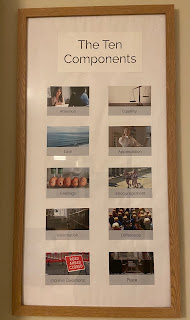This week I ran a session at the
AHUA (Association of Heads of University Administration) conference in Leeds. It was called
Listening, Difference and Psychological Safety and was about facilitating conversations about topics where the discourse has become so toxic on campus that it seems people are determined not to listen to those with other views (the trans/GC issue, and the conflict in the Middle East are two current examples).
I started, very deliberately, with a few processes and activities designed to generate and strengthen a sense of psychological safety in the room, including a series of Rounds at the small tables around which participants were gathered (See here for some reflections on why Rounds are so effective at creating Psychological Safety).
I then pointed out what I had done and why: how my introduction, use of rounds (and the questions I'd chosen to ask them) and use of humour were all designed to calm the amygdala, and invite them to engage their pro-social (rather than fight-or-flight) operating systems (if this is new to you, see
here).
That led us onto why I was running the session: the problem I was seeking to address (and one which they all recognised: they had, after all, chosen to attend this session rather than the others on offer at the same time). I shared some experiences of being told by academics and professional staff in universities of topics that were not safe to discuss, and my unease at that, and my belief that Nancy Kline's work had something to offer here.
Then I described the experiment we had run at the Thinking Environment Collegiate. of getting people with strongly-held opposing views to have a dialogue, with the brief to understand the other and seek to be understood (but not to persuade or seek to persuade). This had the effect of changing neither party's beliefs, but (and this was the interesting and valuable bit) each person felt more positively about the other after the discussion than before - not the usual result of such exchanges. (I have written about this more extensively here).
We then discussed the components of a Thinking Environment in a little more detail, and in particular the dialogue process. In this, two people agree on the question to be addressed. Then Person 1 asks Person 2 the question, and listens, with complete attention, and above all without interrupting, while Person 2 thinks out loud about the question. Person 2 has the discipline only to talk for 2 or 3 minutes, and then ask Person 1: What do you think? Person 2 then listens, with complete attention, and above all without interrupting, while Person 1 thinks out loud about the question (which may or may not include picking up themes from Person 2's thoughts). Person 1 has the discipline only to talk for 2 or 3 minutes, and then ask Person 2: What do you think? and so on.
This process is extraordinary. Each person, knowing that he or she will not be interrupted, is free to think, without urgency, and knowing that he or she will have a further turn also releases pressure. Paying heed to the other, by not talking too long, and by inviting the other to think in turn, also transforms the conversation; and above all, genuinely listening to the other, seeking to understand, changes the whole emotional dynamic.
So having described that, I got them to do it. And they found the results as powerful as I had promised.
Finally I got them to appreciate the person with whom they had had the dialogue, and share a key learning in a final round in plenary.
The feedback was very powerful: not least as people felt they had some practical techniques they could go away and implement with a high level of confidence.
And many committed to coming to the AHUA Diversity of Viewpoints Workshop which I will be running in London in September, to explore these ideas, and this approach, in more depth.












